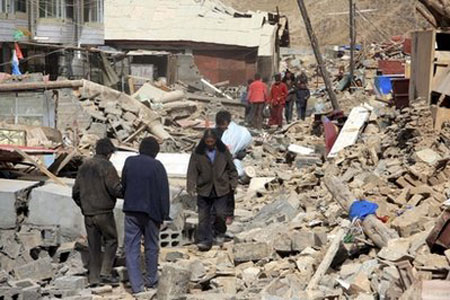Earthquakes in China are very unusual
Instead of appearing at the intersection of two tectonic plates like the big earthquakes of the year, the earthquake in China yesterday occurred inside a tectonic plate.

The earthquake in China on April 14 appears between a plate of tectonic plates.Photo: AP.
The magnitude of the magnitude 6.9 magnitude occurred near Ngoc Thu district, Thanh Hai province at 7:49 on April 14, according to local time. The earthquake-prone area is part of the Tibetan plateau - more than 5 km from sea level.
The Livescience said the Tibetan plateau, along with the Himalayas, was created 50 million years ago when part of the Indian subcontinent began to touch the Eurasian continent.
But the unusual thing is that yesterday's earthquake did not occur at the meeting point of two tectonic plates. Instead, it happened right in the middle of the Tibetan plateau. This is the conclusion of Randy Baldwin, geophysicist of the US National Earthquake Information Center. The bloodiest earthquake in human history - occurring in Shaanxi Province, China in 1556 and killing 830,000 people - also happened inside the tectonic plate.
The Tibetan Plateau continues to be raised by its own process of creation, while being pressed and pulled by many other forces. Those forces create many milling lines (also called broken lines) on the plateau. Scientists have not determined which milling line broke in the earthquake yesterday. Baldwin thinks it could be a shallow milling line. The two sides of the milling line move in opposite directions, releasing a tremendous amount of energy.
Although the earthquake in Qinghai is completely different from the earthquake in Haiti and Chile, their signs are still the same.
'All earthquakes have a geological feature in common. First, they all generate p-shaped waves that vibration detectors can detect. Then the S-shaped wave appears. The time interval between P waves and S waves allows geologists to locate the earthquake , 'Baldwin explained.
Baldwin said the earthquake area in Qinghai still suffered from aftershocks since yesterday. These aftershocks are from 4.8 to 5.8 on the Richter scale. The number and intensity of aftershocks will decrease over time.
- Earthquakes continuously shook northeast China
- The number of people killed by double seismic in China increased to 89
- 381 people died in strong earthquakes in China
- Again earthquakes in Yunnan, China injured 19 people
- Double earthquake struck Sichuan, China, 12 people were killed
- An earthquake occurred in Vanuatu, Mexico and China
- The scene dissipated in Van Nam after the earthquake
- China: There is a continuous earthquake in Sichuan
- Hanoi sensed shaking due to earthquakes in Yunnan, China
- 'Super moon' is about to cause earthquakes, tsunamis?
- Hundreds of houses collapsed due to earthquakes in China
- 2 earthquakes shook western China
 Is the magnetic North Pole shift dangerous to humanity?
Is the magnetic North Pole shift dangerous to humanity? Washington legalizes the recycling of human bodies into fertilizer
Washington legalizes the recycling of human bodies into fertilizer Lightning stone - the mysterious guest
Lightning stone - the mysterious guest Stunned by the mysterious sunset, strange appearance
Stunned by the mysterious sunset, strange appearance